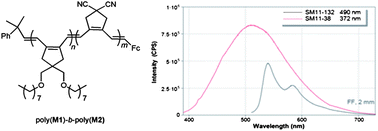The synthesis of AB-type block copolymers of 4,4-bis(octyloxymethyl)-1,6-heptadiyne (M1) and dipropargyl malonodinitrile (M2) via metathesis-based cyclopolymerization using well-defined molybdenum- and ruthenium-based initiators is described. While backbiting reactions were observed in the case where polymerizations were triggered by [Ru(NCO)2(IMesH2)(![[double bond, length as m-dash]](https://www.rsc.org/images/entities/char_e001.gif) CH-2-(2-PrO)–C6H4] (I2) and [Ru(NCO)2(3-Br-Py)2(IMesH2)(CHPh)] (I3), (IMesH2 = 1,3-dimesitylimidazolin-2-ylidene, 3-Br-Py = 3-bromopyridine), the use of RuCl2(Py)2(IMesH2)(CHPh) (I1) in THF allowed for the synthesis of poly(M1) without any backbiting, though with a broad PDI. Block copolymers, i.e. poly(M1)-b-poly(M2), could be prepared in a living manner without any backbiting by the use of the Mo-based Schrock-type initiator Mo(N-2,6-i-Pr2C6H3)(CHCMe2Ph)(OCH(CH3)2)2 (I4) and THF as solvent. Poly(M1)-b-poly(M2) was characterized by UV and fluorescence spectroscopy and used for the construction of a photovoltaic device.
CH-2-(2-PrO)–C6H4] (I2) and [Ru(NCO)2(3-Br-Py)2(IMesH2)(CHPh)] (I3), (IMesH2 = 1,3-dimesitylimidazolin-2-ylidene, 3-Br-Py = 3-bromopyridine), the use of RuCl2(Py)2(IMesH2)(CHPh) (I1) in THF allowed for the synthesis of poly(M1) without any backbiting, though with a broad PDI. Block copolymers, i.e. poly(M1)-b-poly(M2), could be prepared in a living manner without any backbiting by the use of the Mo-based Schrock-type initiator Mo(N-2,6-i-Pr2C6H3)(CHCMe2Ph)(OCH(CH3)2)2 (I4) and THF as solvent. Poly(M1)-b-poly(M2) was characterized by UV and fluorescence spectroscopy and used for the construction of a photovoltaic device.
You have access to this article
 Please wait while we load your content...
Something went wrong. Try again?
Please wait while we load your content...
Something went wrong. Try again?
![[double bond, length as m-dash]](https://www.rsc.org/images/entities/char_e001.gif) CH-2-(2-PrO)–C6H4] (I2) and [Ru(NCO)2(3-Br-Py)2(IMesH2)(CHPh)] (I3), (IMesH2 = 1,3-dimesitylimidazolin-2-ylidene, 3-Br-Py =
CH-2-(2-PrO)–C6H4] (I2) and [Ru(NCO)2(3-Br-Py)2(IMesH2)(CHPh)] (I3), (IMesH2 = 1,3-dimesitylimidazolin-2-ylidene, 3-Br-Py = 

 Please wait while we load your content...
Please wait while we load your content...